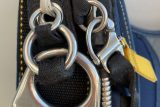Skydiving Backup (Reserve) Parachutes Explained
General
2 years ago
Do Skydivers Have a Backup?
Do skydivers have backup parachutes? Of COURSE, skydivers have a backup (aka reserve) chute … we’re not that crazy! Skydiving backup parachutes are deployed in the event of an inability to deploy the main parachute, or a malfunction of the main parachute once it has been deployed. Stuff happens, but we’re skydivers, so we’re ready for anything! Let’s get into it.
What is a Backup Parachute (AKA Reserve Parachute)?
What is a skydiving backup parachute called? The second of two canopies inside a skydiving rig is called a reserve, a parachute that is used in the event of an emergency situation. While skydivers use their main canopy on every jump, the reserve is there as a “just in case.” Although they’re both rectangular pieces of fabric that will guide us softly to the ground, there are some major differences.

How is a Reserve Parachute Different from a Main?
Three major differences of the reserve parachute vs main are the design, size, and who can handle it.
- Design. A reserve parachute has this sole purpose: deploy fast and be reliable. While main canopies can possess a variety of design characteristics that make them fun to fly, a reserve will do one job: get you safely to the ground.
- What happens if your backup parachute fails? This is so rare and unheard of that there aren’t even proper statistics on it. If a reserve parachute has a less-than-ideal deployment, skydivers will focus on the task at hand and rely on their training and expertise in order to ensure their reserve can function properly. Remember: parachutes are designed to open – it’s their whole purpose!
- Size. As skydivers advance in the sport they’ll often do something called downsizing. This is when you decrease the size of your main canopy over time as you gain experience, which will result in an increased wing-loading – which let’s you go faster. On the contrary, a reserve will pretty much remain the same size throughout the skydiver’s career. Even if the skydiver has a teeny-tiny main, it is common that the reserve be much bigger.
Don’t touch it! Parachute riggers are the only ones qualified to inspect and pack a reserve parachute after it has been deployed or if it is due for a repack (which must be done every 180 days). In contrast, main canopies can be packed by the person who will jump it next, a rigger, or someone under the direct supervision of a rigger. Riggers require certification from the Federal Aviation Administration which proves they can handle a reserve with extreme care – serious stuff!
How do Skydivers Pull Their Backup Parachute?
If you’re asking, “What is a cutaway in skydiving?” We’ve got you covered! Skydivers deploy their reserve by enacting “emergency procedures” or EPs. Essentially, it’s the act of getting rid of your main and beginning to use the reserve.
When we are ready to deploy our main canopy, we will reach to the bottom of our parachute container and pull something called a pilot chute – a circular piece of fabric that is attached to our main canopy with a long piece of nylon webbing called a bridle. When the pilot chute is thrown it will catch air and, through a quick series of events, pull the bag of your main canopy off of your back and out of its container. If the main canopy is not square, stable, and steerable and the problem cannot be corrected, the jumper will conduct emergency procedures.
There are two handles on the front of the rig: one on the right of your belly and one on the left. The jumper will fully pull off the handle on the right to release the main from the rig and then pull off the left one to deploy the reserve. The releasing of the main is called a cutaway!
- Here are some reserve parachute statistics for ya’! In 2021, the United States Parachute Association (USPA) stated that 721 skydivers reported using their reserve parachute. The number of jumps made during this year was around 3.57 MILLION. The odds are definitely in our favor!
Do Reserve Parachutes Automatically Deploy?
While the jumper is responsible for deploying their reserve, there are two nifty apparatuses that can help us out – the RSL, MARD, and the AAD!
- RSL — Simply put, a reserve static line (or reserve static lanyard) is a lanyard that is fastened to a part of the main canopy and the reserve cord or pin (which is released in order to deploy the reserve). Since it is attached to the main canopy, in the event of a cutaway and the main flying off to no man’s land, it is designed to simultaneously pull the reserve pin and deploy the reserve!
- MARD — This is a Main Assisted Reserve Deployment system, which is essentially a direct-bag static line of the reserve parachute off of the main that allows for quicker deployment of the reserve parachute.
- AAD — An automatic activation device is a small computer (think: the size of your pinky) that is designed to deploy the reserve parachute if the jumper can’t do it themselves. While falling through the sky, the AAD is able to use air pressure to determine the speed and altitude of the skydiver. If the jumper is traveling at a velocity that is deemed too fast at a predetermined (and low) altitude, the AAD will fire, deploying the reserve canopy. AADs save lives!
We hope we cleared up the question, “Do skydivers have two parachutes” and put your mind at ease! We can’t wait to jump with you at Skydive Carolina – book today! We welcome all questions and concerns, please don’t hesitate to reach out to us.




